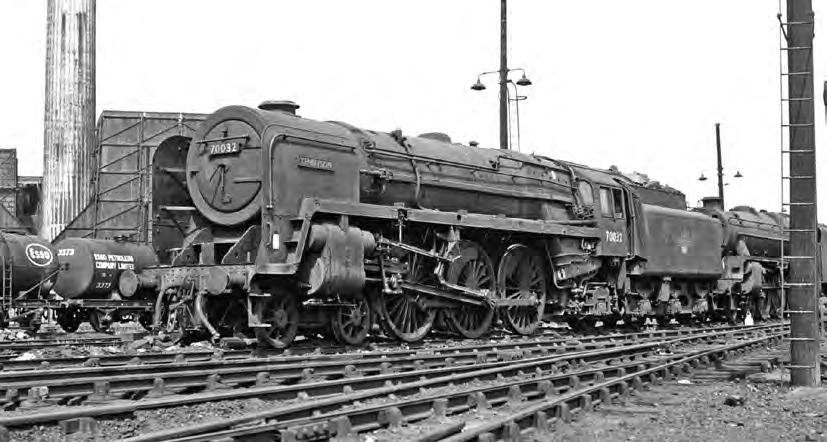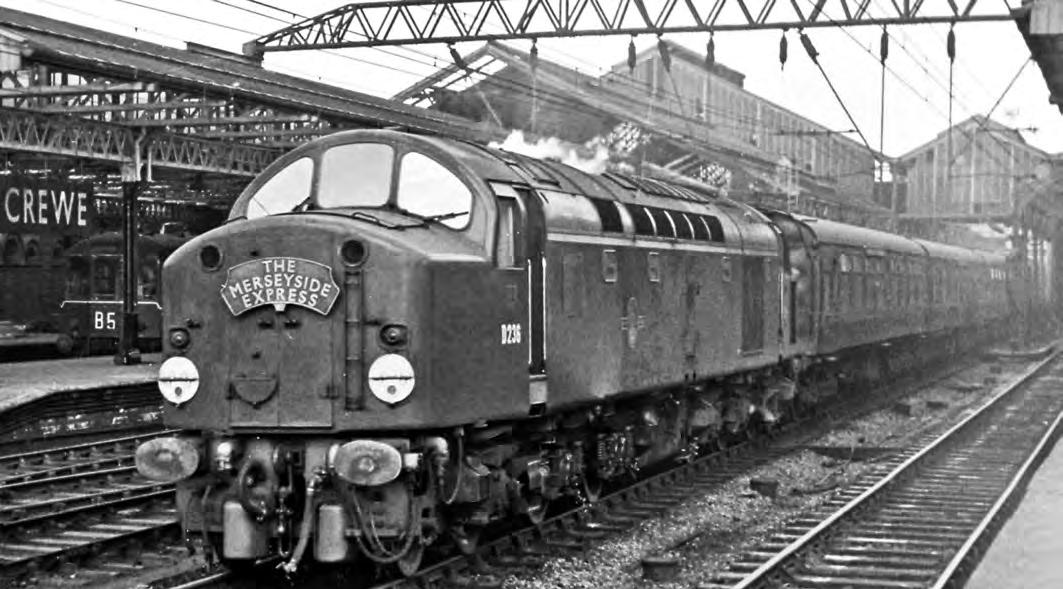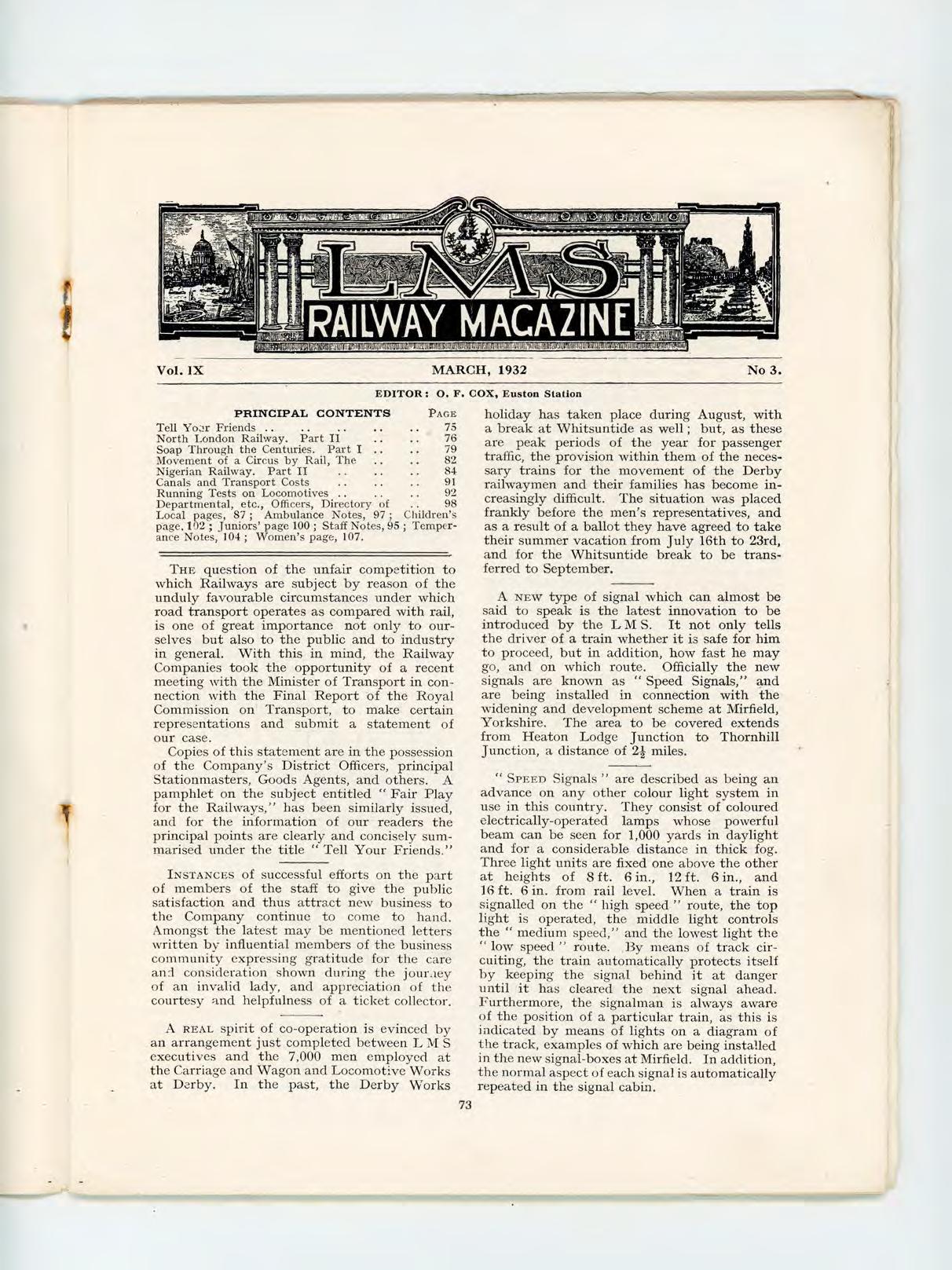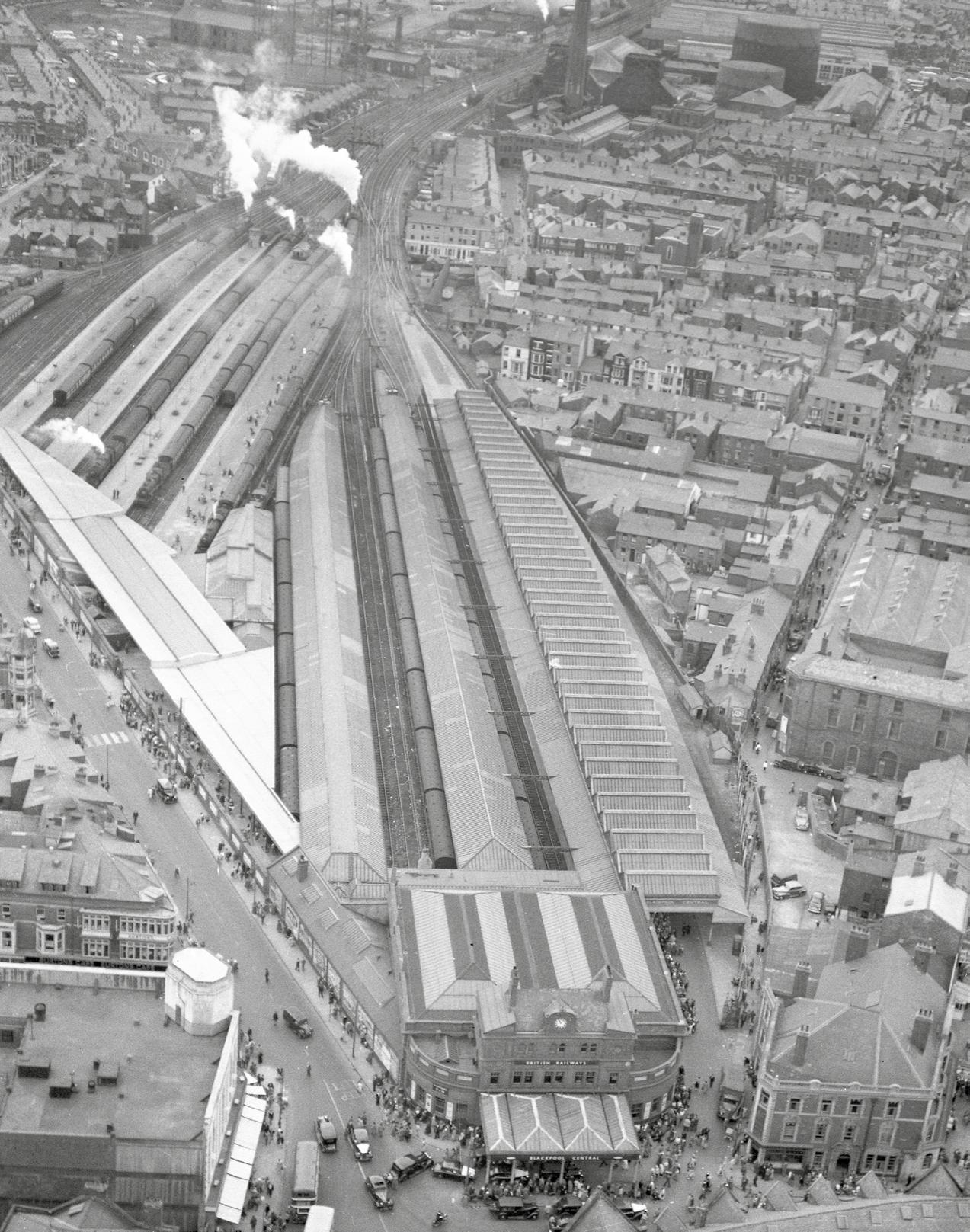
The new history periodical for students of the BR(M), LMS and pre-grouping constituents
Issue no. 5 • July 2024


The new history periodical for students of the BR(M), LMS and pre-grouping constituents
Issue no. 5 • July 2024






Top: Princess Coronation No. 46251 City of Nottingham was a member of one of the most glamorous and admired classes of steam locomotives within the BR stable, but its run-down and almost derelict surroundings here at Camden shed (1B) in July 1964 are the very antithesis of such a description. This itinerant Pacific moved home no fewer than 21 times in the 20 years between being delivered new to Crewe North shed in June 1944 and its withdrawal in September 1964, two months after this photograph was taken. Camden was one of Geoff Courtney’s favourite London depots, despite his inability to ‘bunk’ the shed.
Photo: Jim Flint and Jim Harbart Collection © The Transport Treasury
Centre: Britannia No. 70032 Tennyson rests between duties at its home WCML shed of Willesden (1A) in the summer of 1961. Geoff had logged the Standard Pacific earlier in the year, on 23rd May, heading a Euston-bound express at Rugby Midland.
Photo: Don Matthews © The Transport Treasury
Left: With its sights set firmly on its Manchester home of Longsight (9A), Britannia No. 70043 Lord Kitchener passes through Carpenders Park, south of Watford, on 26th April 1958 with a Down express to the city. This 1953-built Pacific was noted by Geoff at Lichfield Trent Valley on 6th August 1960 also heading for Manchester, with the Down ‘Lancastrian.’
Photo: AS D22-2
© The Transport Treasury

Above: Class 40 D236 provides a powerful message that the steam era is coming to a close as it passes through Crewe with the Up ‘Merseyside Express’ on 14th April 1960, four months before Geoff Courtney logged classmate D230 on the same working at Lichfield Trent Valley on 6th August. Photo: Ben Brooksbank/Creative Commons
Below: The Midland Pullman is the centre of attention as it passes the 1911-built Leicester North signal box on the Midland Main Line in 1960. This six-car diesel-electric train was noted at Bedford Midland Road on trial on 7th March that year. Photo: © The Transport Treasury

The Rail and Canal Traffic Act of 1854 was passed to maintain a degree of competitiveness between rail and canal systems. Under this Act the railways were obliged to carry any and all goods offered to them, other than where these might damage the rolling stock used or where they were physically too large for the bridges, tunnels and passing traffic on the line. Examples of the goods that could be refused would be materials such as tar coated stone chippings (tarmac) or lime, and a firm might prefer to use its own rolling stock to avoid contamination of its product by other cargoes, an example of this would be salt. Following this act and other subsequent legislation the term ‘common carriers’ came into use, referring to this obligation to carry goods offered no matter how small the consignment. The 1854 Act also introduced a government regulated national system of charges for freight moved by rail, based on the weight and value of goods carried.
These two factors, the obligation as common carriers and the Government regulated charges structure, were to become the two biggest obstacles to the railway's ability to compete with road transport. A single low-value consignment had to be booked in, loaded into a wagon, transported to a transshipment depot, transferred to another wagon possibly as its sole cargo, this would then be taken perhaps to yet another yard before being attached to the local ‘pick-up’ goods train to be dropped off at the nearest station to its destination. The revenue on the cargo probably only paid for the time of the booking clerk. The 1888 Railway and Canal Traffic Act changed the law so that the Government could place a ceiling on the rates charged by the railways. All companies were required to submit their rates for review at a public hearing and all rates had to be listed in a Rate Book, which was to be made available to the public.
In 1893 the new government ordered railway rates came into force and the railways naturally increased the charges to the maximum allowed in order to recover the losses on enforced discounts. There was a public outcry at the time and another Royal Commission on Railways was hastily set up to review the law. This resulted in more legislation, further restricting the freedom of the railways in altering their charges and leaving them no room for competition other than in the additional services and facilities they could provide.
Constrained by legislation on charging, British main line railway companies began a period of intense competition based on providing better facilities for the customers. Smaller lines could not operate successfully under these conditions and many
were purchased or leased by larger concerns. The larger companies were also running into difficulties and dividends were reduced to shareholders. The Midland Railway had improved conditions for third class passengers some years before and this had to be matched by other companies, resulting in an average threefold increase in the weight of train per passenger carried. There was fierce competition for goods traffic, even if it made a loss there would still be some contribution from each consignment toward the fixed costs of operating the railway.
The Government control over railway rates, which were still based upon the value of the cargo carried, coupled with the obligation to carry any goods offered, became a serious problem for the railways with the growth of the petrol driven road lorry traffic in the late 1920s. Road haulage was not governed by the same ‘common carriers’ legislation, so a road haulier could offer to carry a high value cargo at a lower cost than the railway, leaving the railway to haul back the low value ‘empties’. The Government had allowed an increase in railway freight charges in 1920 but then prevented any further rise until 1937. By the mid-1930s competition from road transport was becoming a serious problem for the railway companies, who launched a ‘fair deal’ publicity campaign. The following selected pages are from the LMS Magazine of March 1932 which illustrate the ‘Fair Play for the Railways’ campaign and an article titled ‘Canals and Transport Costs’ which discusses the railway’s advantage over canals
It was the Transport Act of 1953 which first substantially altered the legislation relating to ‘common carriers’ and allowed British Railways to refuse less profitable cargo. Sundries traffic was transferred to National Freight Carriers in 1964 although the railways pulled out of this business completely in 1968. Railway parcels traffic was carried until 1981, after that the Red Star parcels service was operated for some years by British Rail until sold into the private sector in 1999.


The first railway from Preston to the Fylde Peninsula was opened by the Preston and Wyre Railway in 1840. It went to Fleetwood, via Kirkham and Poulton-leFylde. This aided the development of Fleetwood as a resort, as a ferry port and as a fishing port. In 1846 a branch was constructed from Poulton to a station which became known as Blackpool Talbot Road (renamed Blackpool North in 1932).
The Blackpool line joined the Fleetwood line via a severe curve and, following a serious derailment on 1st July 1893, the layout at Poulton was completely redesigned to improve the alignment of the Blackpool route. Another branch opened in 1846, from Kirkham to Lytham. By 1874, the separate railway from Lytham to Blackpool had been joined to the Kirkham to Lytham branch, providing a roundabout route to Blackpool following the coast which ended at a well-situated terminus appropriately called Blackpool Central.
The growth of tourist traffic led to four running lines being provided from Kirkham North Junction to Preston, paired by use, in 1889. Even on the four track sections, congestion was a problem and additional signal boxes were installed with running signals and either no points or just emergency trailing crossovers as a means of ‘shortening the block’, allowing trains to follow one another more closely. The circuitous route from Kirkham North Junction to Blackpool Central limited capacity, so a ‘New Line’ was built in 1903, running in a virtually straight line from Kirkham North Junction to a junction at Blackpool South from where four running lines were provided to Blackpool Central. Four running lines were also provided through Poultonle-Fylde station.
Blackpool to Preston in recent times
As car and coach travel grew, the demand for trains reduced. The impressive railway infrastructure which had allowed large numbers of passengers to be transported was either reduced or abandoned. The direct line from Kirkham North Junction to Blackpool Central was abandoned (apart from around one mile at the Kirkham end which was retained as a Tip Siding). The M55 motorway was built on the rest of the trackbed.
The branch from Kirkham to Lytham and Blackpool was cut back to Blackpool South in 1970 and, from 1982, a single uninviting windswept platform has terminated a singled line from Kirkham which is operated as a ‘long siding’.
In 1966, Fleetwood station was closed but a passenger service continued to operate to Wyre Dock until 1970. The branch from Poulton was then used by freight trains as far as the chemical works at Burn Naze. Today, the whole branch is closed but the
line is still extant (albeit overgrown and disused). Since June 2006, there have been plans by Poulton & Wyre Railway Society to restore (and preserve) the passenger rail link towards Fleetwood via Thornton & Cleveleys, as a heritage railway.
Blackpool Central
Opened in April 1863 as Hounds Hill, it became Blackpool Central in 1878. As excursion traffic grew the station was enlarged in 1901, platforms 7 to 14 being used solely for the heavy summer traffic. The line into Central was controlled by 13 signal boxes as there were extensive carriage yards at Spen Dyke, Bloomfield Road and Waterloo Road – these had siding space for 40 complete trains but were often full, necessitating stabling at nearby locations such as St. Annes, Ansdell and Fairhaven, Lytham and Kirkham amongst others.
In November 1964, after just over 100 years in use, Blackpool Central was closed, this occurred even after the recommendation of British Railways that it should remain open. Blackpool Corporation successfully lobbied British Railways for the closure so that it could realise the potential redevelopment of the site, including – the ultimate irony – road vehicle parking.
When closed, around 18½ miles of track and 39,000 sleepers were removed from the station site and carriage yards.
Opened as plain Blackpool in 1846 along with the branch from Poulton, it became Blackpool Talbot Road in 1872. The original station was rebuilt in 1898. The rebuilt station consisted of two parallel train sheds and a terminal building, in Dickson Road between Talbot Road and Queen Street. Platforms 1 to 6 were located in the sheds. In addition, there was effectively a separate station at the east end of Queen Street, with open excursion platforms 7 to 16.
After the reprieve of closure in 1964 the station was to be rebuilt in 1974. The train shed was demolished and the excursion platforms then became the new terminus with the 1938-built platform canopy being refurbished to become the new station building.
Opened in 1903 as Waterloo Road, an additional island platform was added to serve the coast line towards Lytham in 1916. The site was also converted into a junction which connected to the Marton Line, and as with the other Blackpool stations there were extensive sidings to cater for the excursion trains.
The station was renamed Blackpool South on 17th March 1932, the final steam hauled service ran on 3rd August 1968.

A late 1950s/early 1960s aerial view from the top of the Tower of Blackpool Central station. It’s a busy scene all around, especially at the excursion platforms which are to the left, there are only two platforms that are free of trains with stock being moved to the sidings. The municipal electricity and gas works are to the top right of the photograph and Central shed can just be seen to the left of the chimney.
Roy Hubble Collection © Transport Treasury
